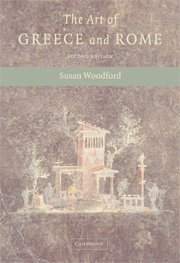Book contents
- Frontmatter
- Contents
- List of Illustrations
- Acknowledgements
- Maps
- Introduction
- PART I THE ARCHAIC AND CLASSICAL PERIODS: PROGRESS AND PROBLEMS
- PART II THE FOURTH CENTURY BC AND THE HELLENISTIC PERIOD: INNOVATION AND RENOVATION
- PART III THE ROMAN WORLD: ADOPTION AND TRANSFORMATION OF THE GREEK LEGACY
- Epilogue
- Appendix: How We Know What We Think We Know
- Glossary
- Further reading
- Index
Appendix: How We Know What We Think We Know
- Frontmatter
- Contents
- List of Illustrations
- Acknowledgements
- Maps
- Introduction
- PART I THE ARCHAIC AND CLASSICAL PERIODS: PROGRESS AND PROBLEMS
- PART II THE FOURTH CENTURY BC AND THE HELLENISTIC PERIOD: INNOVATION AND RENOVATION
- PART III THE ROMAN WORLD: ADOPTION AND TRANSFORMATION OF THE GREEK LEGACY
- Epilogue
- Appendix: How We Know What We Think We Know
- Glossary
- Further reading
- Index
Summary
Confronting what is left of Greek and Roman art is like entering a hopelessly chaotic museum where most of the exhibits have no labels and such labels as exist have all been thrown helter-skelter into some barely sorted piles. We have the actual remains of works of art – buildings, sculptures, paintings, vases, mosaics and suchlike – but seldom with any information attached to them that indicates when they were made, by whom, or for what purpose.
Fortunately, apart from these physical objects, we have some written sources of information (see Chap. 3, pp.): histories, biographies and inscribed stones. The literary works lack illustrations, and the inscribed stones – often naming the dedicator and the artist – are usually only bases that once supported statues now lost. An important task in trying to understand Greek and Roman art is to attach what has survived in written records to what has survived physically.
A few examples follow of how the history of Greek and Roman art has been built up into a deceptively clear account.
HOW GREEK AND ROMAN WORKS OF ART AND ARCHITECTURE CAN BE DATED
Plutarch, who lived in the 1st and 2nd centuries ad, wrote a biography of the Athenian statesman Pericles in which he mentioned the buildings erected under Pericles' influence. Among them is the Parthenon (Plutarch Life of Pericles 13, 31). Other sources give us dates for Pericles.
- Type
- Chapter
- Information
- The Art of Greece and Rome , pp. 139 - 145Publisher: Cambridge University PressPrint publication year: 2004



